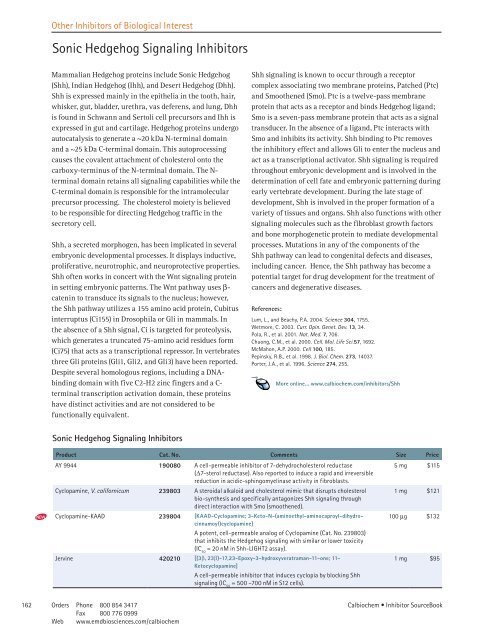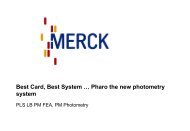Inhibitor SourceBook™ Second Edition
Inhibitor SourceBook™ Second Edition
Inhibitor SourceBook™ Second Edition
Create successful ePaper yourself
Turn your PDF publications into a flip-book with our unique Google optimized e-Paper software.
Other <strong>Inhibitor</strong>s of Biological Interest<br />
Sonic Hedgehog Signaling <strong>Inhibitor</strong>s<br />
Mammalian Hedgehog proteins include Sonic Hedgehog<br />
(Shh), Indian Hedgehog (Ihh), and Desert Hedgehog (Dhh).<br />
Shh is expressed mainly in the epithelia in the tooth, hair,<br />
whisker, gut, bladder, urethra, vas deferens, and lung, Dhh<br />
is found in Schwann and Sertoli cell precursors and Ihh is<br />
expressed in gut and cartilage. Hedgehog proteins undergo<br />
autocatalysis to generate a ~20 kDa N-terminal domain<br />
and a ~25 kDa C-terminal domain. This autoprocessing<br />
causes the covalent attachment of cholesterol onto the<br />
carboxy-terminus of the N-terminal domain. The Nterminal<br />
domain retains all signaling capabilities while the<br />
C-terminal domain is responsible for the intramolecular<br />
precursor processing. The cholesterol moiety is believed<br />
to be responsible for directing Hedgehog traffic in the<br />
secretory cell.<br />
Shh, a secreted morphogen, has been implicated in several<br />
embryonic developmental processes. It displays inductive,<br />
proliferative, neurotrophic, and neuroprotective properties.<br />
Shh often works in concert with the Wnt signaling protein<br />
in setting embryonic patterns. The Wnt pathway uses bcatenin<br />
to transduce its signals to the nucleus; however,<br />
the Shh pathway utilizes a 155 amino acid protein, Cubitus<br />
interruptus (Ci155) in Drosophila or Gli in mammals. In<br />
the absence of a Shh signal, Ci is targeted for proteolysis,<br />
which generates a truncated 75-amino acid residues form<br />
(Ci75) that acts as a transcriptional repressor. In vertebrates<br />
three Gli proteins (Gli1, Gli2, and Gli3) have been reported.<br />
Despite several homologous regions, including a DNAbinding<br />
domain with five C2-H2 zinc fingers and a Cterminal<br />
transcription activation domain, these proteins<br />
have distinct activities and are not considered to be<br />
functionally equivalent.<br />
Sonic Hedgehog Signaling <strong>Inhibitor</strong>s<br />
Shh signaling is known to occur through a receptor<br />
complex associating two membrane proteins, Patched (Ptc)<br />
and Smoothened (Smo). Ptc is a twelve-pass membrane<br />
protein that acts as a receptor and binds Hedgehog ligand;<br />
Smo is a seven-pass membrane protein that acts as a signal<br />
transducer. In the absence of a ligand, Ptc interacts with<br />
Smo and inhibits its activity. Shh binding to Ptc removes<br />
the inhibitory effect and allows Gli to enter the nucleus and<br />
act as a transcriptional activator. Shh signaling is required<br />
throughout embryonic development and is involved in the<br />
determination of cell fate and embryonic patterning during<br />
early vertebrate development. During the late stage of<br />
development, Shh is involved in the proper formation of a<br />
variety of tissues and organs. Shh also functions with other<br />
signaling molecules such as the fibroblast growth factors<br />
and bone morphogenetic protein to mediate developmental<br />
processes. Mutations in any of the components of the<br />
Shh pathway can lead to congenital defects and diseases,<br />
including cancer. Hence, the Shh pathway has become a<br />
potential target for drug development for the treatment of<br />
cancers and degenerative diseases.<br />
References:<br />
Lum, L., and Beachy, P.A. 2004. Science 304, 755.<br />
Wetmore, C. 2003. Curr. Opin. Genet. Dev. 13, 34.<br />
Pola, R., et al. 200 . Nat. Med. 7, 706.<br />
Chuong, C.M., et al. 2000. Cell. Mol. Life Sci.57, 692.<br />
McMahon, A.P. 2000. Cell 100, 85.<br />
Pepinsky, R.B., et al. 998. J. Biol. Chem. 273, 4037.<br />
Porter, J.A., et al. 996. Science 274, 255.<br />
More online... www.calbiochem.com/inhibitors/Shh<br />
Product Cat. No. Comments Size Price<br />
AY 9944 190080 A cell-permeable inhibitor of 7-dehydrocholesterol reductase<br />
(D7-sterol reductase). Also reported to induce a rapid and irreversible<br />
reduction in acidic-sphingomyelinase activity in fibroblasts.<br />
Cyclopamine, V. californicum 239803 A steroidal alkaloid and cholesterol mimic that disrupts cholesterol<br />
bio-synthesis and specifically antagonizes Shh signaling through<br />
direct interaction with Smo (smoothened).<br />
N Cyclopamine-KAAD 239804 [KAAD-Cyclopamine; 3-Keto-N-(aminoethyl-aminocaproyl-dihydro-<br />
cinnamoyl)cyclopamine]<br />
A potent, cell-permeable analog of Cyclopamine (Cat. No. 239803)<br />
that inhibits the Hedgehog signaling with similar or lower toxicity<br />
(IC 50 = 20 nM in Shh-LIGHT2 assay).<br />
Jervine 420210 [(3b, 23b)-17,23-Epoxy-3-hydroxyveratraman-11-one; 11-<br />
Ketocyclopamine]<br />
A cell-permeable inhibitor that induces cyclopia by blocking Shh<br />
signaling (IC 50 = 500 –700 nM in S 2 cells).<br />
5 mg $ 5<br />
mg $ 2<br />
00 mg $ 32<br />
mg $95<br />
62 Orders Phone 800 854 34 7<br />
Calbiochem • <strong>Inhibitor</strong> SourceBook<br />
Fax 800 776 0999<br />
Web www.emdbiosciences.com/calbiochem



